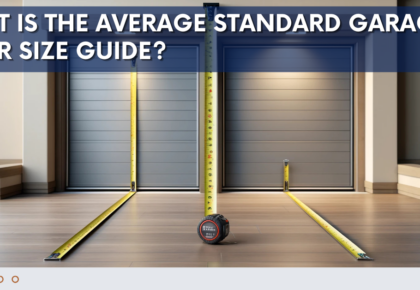Did you know that a poorly weatherproofed garage can be the reason for your high energy bill and damage to stored items? Whether frigid cold, super hot, or just plain muggy, your garage should be ready for extreme weather.
This guide will help you easily weatherproof a garage. What we have is a coverage of some great ideas from simple fixes to the best extreme-climate garage solutions that keep your garage safe and comfortable year-round.
Assessing Your Garage: The First Step to Effective Weatherproofing
Inspecting the property
First things first: before moving to weatherproofing matters, you must appraise the present situation that the garage is in. Begin with a thorough examination:
- Doors and Windows: Search for drafts and gaps all around. Ensure the seals are good and the windows fit close.
- Walls and Floors: Check for chinks, the wall and floor joints that would allow the ingress of moisture or air.
- Roof: Check for leaking parts, damaged and missing shingles, or any areas that might possibly be susceptible to infiltration.
- Ventilation: Determine if the garage area is sufficiently well ventilated to regulate temperatures and maintain moisture conditions during the seasons.
Inspection should point up corrective action required so you can prioritize your weatherizing efforts.
Climate-Specific Prioritization
Depending on the region that you are in, one major need will vary geographically, hence ironically depending on where you live. If you are from the cold areas, this is the point where insulating and sealing your garage should top the list to prevent freezing in the cold. If based out of the hot regions, you might be expected to have ventilation and reflection of heat. By understanding the specific needs of your environment, you can focus on the most critical weatherproofing tasks.
Insulating Your Garage: The Backbone of Weatherproofing
Comprehensive Insulation Strategies
Insulated, your garage will be temperature stable, even against cold or heat of the utmost severity.
Wall and Ceiling Insulation
Begin with insulating the walls and the ceiling because this is the area through which one can have major heat gains and losses. Common insulation materials for such a structure are fiberglass, foam board, and spray foam; they are effective. There should be insulation between the wall’s wooden studs and throughout the length of the ceiling.
Garage Door Insulation
The garage door is the major source through which most temperature differentials are ascertained. The insulating of it would ensure considerable comfort. Most garage doors can fit insulation kits with foam board or reflective insulation kits of pre-cut panels. Such kits are very easy to install and will generally increase energy efficiency within the garage.
Insulation Comparison Table
To help you choose the right insulation for your garage, here’s a comparison of the most common types:
| Insulation Type | Material | Best For | Benefits | Drawbacks |
| Fiberglass | Fiberglass batts/rolls | Walls and ceilings | Good thermal resistance, easy to install | Can irritate skin, not moisture-resistant |
| Foam Board | Rigid foam panels | Walls, ceilings, doors | High insulating value, moisture-resistant | Requires precise cutting, can be expensive |
| Spray Foam | Polyurethane foam | Walls, ceilings, gaps | Excellent insulation, seals gaps, moisture-resistant | Requires professional installation, higher cost |
| Reflective Insulation | Reflective foil/bubble wrap | Garage doors, attics | Reflects heat, lightweight, easy to install | Less effective in cold climates, best as a supplementary insulation |
This table helps you quickly compare insulation options based on your specific needs and budget.

Sealing Gaps and Cracks: Stopping Weather Intrusions
There are small gaps and cracks, whereby even the best insulation may allow cold air or moisture in. Seal off any gaps around the windows, doors, and other openings with weather-resistant caulk. Another effective way to block drafts and keep indoor temperature stable is the application of weatherstripping around the edges of your garage door.
Climate Control: Tailored Solutions for Hot and Cold Climates
Winterizing Your Garage
Heating Options
For example, if you keep a car or other sensitive equipment in the garage, in many regions of the country, it becomes incredibly important to keep the temperature above the freezing point. Solutions can be very simple: portable space heaters. More fixed approaches to radiant heating and forced air heaters help to produce even warmth that can be adjusted to your comfort level.
Moisture Control
Cold weather often bears moisture into the garage, with moisture settling in the form of melting snow, rain, or condensation. Put a vapor barrier on all walls and floors to keep moisture out. This would help if, during the winter months, you used a dehumidifier, which would work by keeping the air dry and preventing the growth of molds or mildew.
Cooling Strategies for Hot Summers
Ventilation
For the hot climates, the not-to-do thing is the conversion of a garage into a furnace, in other words, well ventilated through the installation of exhaust fans, birds or any other kind of vents for air circulation. The use of passive ventilation systems like ridge and soffit vents can play a very important role in the purpose of enhancing airflow.
Reflective Materials
Apply reflective coatings or light-colored paint to the exterior of your garage to avoid heat absorption. These materials reject the sun’s rays and, in return, ensure your garage is cooler and more comfortable in summer.
Affordable Climate Control Tips
Your garage has much more potential than just added space to work or store. Whether on a budget or not, there are plenty of ways to control the climate other than a whole-structure HVAC setup that can cost a fortune. Window air conditioning solutions, portable fans, and even simple insulation upgrades can go a long way to ensuring that it’s kept at the right temperature.
Battling Humidity and Moisture: Keeping Your Garage Dry
Waterproofing the Structure
Moisture control is key in humid climates for the prevention of rust, mold, and structural damage. Apply a waterproof coating to the floors and walls first. This creates a barrier to preclude seepage of water into the concrete. Make sure also that the structure is well graded so there is drainage away from the structure instead of having water pool around your garage.
Mold and Mildew Prevention
Mold and mildew generally grow well in moist and poorly ventilated areas. Keep the garage well ventilated to avoid the growth. In the event that mold develops, clean immediately with a mixture of water and bleach, and try to reduce the humidity by either using a dehumidifier or adding more ventilation.
Storm-Proofing: Preparing for High Winds and Severe Weather
Reinforcing Garage Doors and Windows
It is very important to reinforce the garage door and windows in places under the threat of storms with high winds so as to maintain the structural integrity of your home. Consider upgrading to wind-resistant garage doors intended to tolerate strong winds and flying debris. If a new door is not an option, you can brace your existing door with bracing kits, and storm shutters can be used on windows in that area or impact-resistant glass.
Securing the Roof and Structure
Apart from these, your garage roof is also one of the more important areas that need strengthening against heavy weather. Keep the roof fastened to the walls with hurricane straps or clips to prevent it from being lifted off during a storm. Regular inspections are also necessary for any damage that may be aggravated by heavy winds or rain.
Emergency Preparedness for Storms
One thing to consider is having an emergency kit in your garage if you are living in a storm-sensitive location. Such kits may include a flashlight, extra batteries, a first-aid kit, and non-perishable food. Also, know how to manually operate your garage door should the power go out. This will allow you continued access in and out of your garage.
DIY Weatherproofing: Cost-Effective and Easy Solutions
Simple and Affordable Fixes
Not every weatherization project requires professional assistance. Many improvements can be done yourself with a minimum number of tools and cost. For instance, applications such as caulking in order to seal cracks, putting in weatherstripping, and insulating your garage door are all tasks that one can accomplish over a weekend.
Seasonal Maintenance
Enhancing the weatherproofing is a way of ensuring that the needed protection covers long-term results. Inspect the seals, insulation, and drainage systems for the garage at the beginning of every season. This step will help you catch potential problems early and keep the garage in top condition.
Advanced Tips and Tricks: Going Beyond the Basics
Incorporating Smart Technology
Take it up a notch; consider utilizing smart technology in garage weatherproofing. Use smart thermostats that can be utilized to control temperatures and sensors capable of alerting you against moisture buildup and drafts; indeed, these systems can be operated from a distance for assurance wherever you are.
Eco-Friendly Weatherproofing
If sustainability is a priority, explore eco-friendly options for weatherproofing your garage. Recycle old materials, use sustainable insulation products, and opt for energy-efficient lighting to reduce your environmental footprint while enhancing your garage’s comfort and protection.
FAQs: Common Questions About Garage Weatherproofing
Do I Need to Insulate My Garage in a Hot Climate?
Yes, insulating your garage is important even in hot climates. It helps keep the garage cooler during the summer and warmer in the winter, making it a more comfortable space year-round.
How Can I Get My Garage Ready for Winter on a Budget?
To this end, insulate the walls and doors of your garage; seal gaps using weatherstripping, and keep the cold out with the active use of space heaters. Simple steps like these can go a long way in improving your garage’s readiness for winter.
How Do I Protect My Garage from Moisture in Humid Weather?
Moisture can cause such severe issues as mold and rust in a humid climate. Applying waterproof coatings on both the floor and wall areas, adding a vapor barrier, and a dehumidifier for moisture absorption will help to keep the air dry, hence protecting your garage.
What’s the Best Way to Make My Garage More Resistant to Storms?
Attach a bracing kit to fortify the garage door or replace the standard door with one that is wind-resistant. Installing storm shutters over the windows, or alternatively, applying impact-resistant window film, will do a lot to enhance your building’s resilience in protecting it from hurricanes.
Ready to Weatherproof Your Garage? We Can Help!
If you want to make your garage even better at handling tough weather or need help with any of the tips we mentioned,MN Garage Squad is here for you. We’re experts in all things garage, like insulation, reinforcing doors, and storm-proofing.
Check out our website at MN Garage Squad to learn more about how we can help protect your garage from extreme weather. Whether it’s freezing winters, hot summers, or storms, we know how to keep your garage safe and comfortable.
Don’t wait, reach out to us today to get started on your weatherproofing project!








